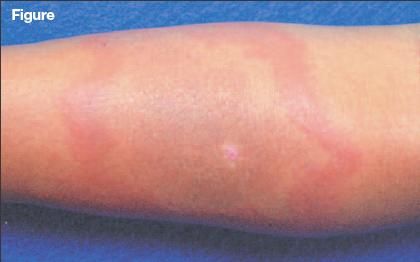- Clinical Technology
- Adult Immunization
- Hepatology
- Pediatric Immunization
- Screening
- Psychiatry
- Allergy
- Women's Health
- Cardiology
- Pediatrics
- Dermatology
- Endocrinology
- Pain Management
- Gastroenterology
- Infectious Disease
- Obesity Medicine
- Rheumatology
- Nephrology
- Neurology
- Pulmonology
Lyme Disease in California
Three weeks after returning from a family vacation in northern California, an 8-year-old boy presented with an unusual rash on his left forearm. He indicated that he had been bitten by an unknown insect while vacationing.
Three weeks after returning from a family vacation in northern California, an 8-year-old boy presented with an unusual rash on his left forearm. He indicated that he had been bitten by an unknown insect while vacationing.
The site of the bite was surrounded by a gradually advancing red margin that was indicative of erythema migrans (Figure). Although the patient denied having any symptoms that were compatible with Lyme disease, he was treated with a 1-month course of amoxicillin pending results of serological testing.

Figure
The results of baseline serological testing using enzyme-linked immunosorbent assay (ELISA) were negative for Lyme disease. Because of strong clinical suspicion, a Western blot analysis was ordered. The results were positive for Lyme disease.
The lesion gradually faded, and the boy has remained asymptomatic. The case was reported to the Orange County public health department.
The first case of Lyme disease in California was reported in 1987, and surveillance of the disease in the state began in 1989. Between 1993 and 2006, 1380 cases of Lyme disease have been documented. The incidence of Lyme disease in the state is low. For 2006, it was 0.2 per 100,000 persons, compared with 56.6 cases per 100,000 persons in Delaware (seconded by Connecticut, where the annual incidence in 2006 was 51.0 cases per 100,000 persons).1
Although the annual incidence in southern California generally ranges from 0 to 5 cases per 100,000 persons, a higher incidence is found in the Pacific Northwest, exceeding 50 cases per 100,000 in parts of Humboldt and Mendocino counties and the San Francisco Bay Area.2 Incidence strongly corresponds with the degree to which Ixodes pacificus is present in any given geographical area in California.2 Thus, incidence of Lyme disease is higher in areas of the state where moist woodland is prominent than in areas characterized by desert and chaparral.
Lyme disease is diagnosed on the basis of clinical findings and a history of possible exposure to ticks. Laboratory tests are generally unnecessary in patients who present with erythema migrans, according to the CDC.3 Serological tests can be both false-negative and false-positive. The recommended protocol is to perform an ELISA or immunofluorescence assay (IFA) followed by a Western blot test to verify ELISA or IFAresults.3
References:
- Reported Lyme disease cases by state, 1993-2006. www.cdc.gov/ncidod/dvbid/lyme/ld_rptdLymeCasesbyState.htm. Accessed April 30, 2008.
- Eisen RJ, Lane RS, Fritz CL, Eisen L. Spatial patterns of Lyme disease risk in California based on disease incidence data and modeling of vector-tick exposure. Am J Trop Med Hyg. 2006;75:669-676.
- Lyme disease diagnosis. www.cdc.gov/ncidod/dvbid/lyme/ld_humandisease_diagnosis.htm. Accessed April 30, 2008.
